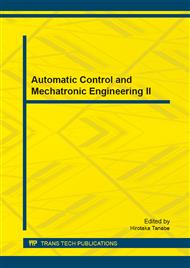[1]
P. K. Menon, T. Lam, L. S. Crawford, V. H. L. Cheng, and L. Altos: Real-Time Computational Methods for SDRE Nonlinear Control of Missiles, American Control Conference, Anchorage, 2002, p.232–237.
DOI: 10.1109/acc.2002.1024809
Google Scholar
[2]
C. P. Mracek and J. R. Cloutier: Full Envelope Missile Longitudinal Autopilot Design Using the State-Dependent Riccati Equation Method, AIAA Guidance, Navigation and Control Conference, New Orleans, 1997, p.1697–1705.
DOI: 10.2514/6.1997-3767
Google Scholar
[3]
J. R. Cloutier and D. T. Stansbery: Nonlinear, Hybrid Bank-to-Turn/Skid-to-Turn Missile Autopilot Design, AIAA Guidance, Navigation and Control Conference, Montreal, 2001, p.1–11.
DOI: 10.2514/6.2001-4158
Google Scholar
[4]
P. K. Menon: Integrated Design of Agile Missile Guidance and Control Systems, 7th Mediterranean Conference on Control and Automation, Haifa, 1999, p.1469–1494.
Google Scholar
[5]
A. Ratnoo and D. Ghose: SDRE Based Guidance Law for Impact Angle Constrained Trajectories, AIAA Guidance, Navigation and Control Conference, South Carolina, (2007).
DOI: 10.2514/6.2007-6539
Google Scholar
[6]
S. S. Vaddi and P. K. Menon: Numerical SDRE Approach for Missile Integrated Guidance-Control, AIAA Guidance, Navigation and Control Conference, South Carolina, (2007).
DOI: 10.2514/6.2007-6672
Google Scholar
[7]
E. W. Bogdanov Alexander: State-Dependent Riccati Equation Control for Small Autonomous Helicopters, Journal of Guidance, Control, and Dynamics, vol. 30, no. 1, p.47–60, (2007).
DOI: 10.2514/1.21910
Google Scholar
[8]
B. A. Steinfeldt and P. Tsiotras: A State-Dependent Riccati Equation Approach to Atmospheric Entry Guidance, AIAA Guidance, Navigation and Control Conference, Toronto, (2010).
DOI: 10.2514/6.2010-8310
Google Scholar
[9]
F. Tyan and J. F. Shen: SDRE Missile Guidance Law, 8th IEEE International Conference on Control and Automation, Xiamen, 2010, p.866–870.
DOI: 10.1109/icca.2010.5524364
Google Scholar
[10]
Tayfun Cimen: State-Dependent Riccati Equation (SDRE) Control : A Survey, 17th World Congress IFAC, Seoul, 2008, p.3761–3775.
DOI: 10.3182/20080706-5-kr-1001.00635
Google Scholar
[11]
Tayfun Cimen: Survey of State-Dependent Riccati Equation in Nonlinear Optimal Feedback Control Synthesis, Journal of Guidance, Control, and Dynamics, vol. 35, no. 4, p.1025–1047, (2012).
DOI: 10.2514/1.55821
Google Scholar
[12]
Tayfun Cimen: Systematic and Effective Design of Nonlinear Feedback Controllers via the State-Dependent Riccati Equation (SDRE) Method, Annual Reviews in Control, vol. 34, no. 1, p.32–51, (2010).
DOI: 10.1016/j.arcontrol.2010.03.001
Google Scholar
[13]
J. S. Shamma and J. R. Cloutier: Existence of SDRE Stabilizing Feedback, Journal of Aerospace Engineering, vol. 1, no. 3, p.1–14, (2002).
Google Scholar
[14]
K. D. Hammett, C. D. Hall, and D. B. Ridgely: Controllability Issues in Nonlinear State-Dependent Riccati Equation Control, Journal of Guidance, Control, and Dynamics, vol. 21, no. 5, p.767–773, (1998).
DOI: 10.2514/2.4304
Google Scholar
[15]
A. Bracci, M. Innocenti, and L. Pollini: Estimation of the Region of Attraction for State-Dependent Riccati Equation Controllers, Journal of Guidance, Control, and Dynamics, vol. 29, no. 6, p.1427–1430, (2006).
DOI: 10.2514/1.22122
Google Scholar
[16]
Q. M. Lam: SDRE Control Stability Criteria and Convergence Issues : Where Are We Today Addressing Practitioners' Concerns ?, Infotech@Aerospace, California, (2012).
DOI: 10.2514/6.2012-2475
Google Scholar
[17]
S. Elloumi, I. Sansa, and N. B. Braiek: On the Stability of Optimal Controlled Systems with SDRE Approach, 9th International Multi-Conference on Systems, Signals and Devices, Chemnitz, (2012).
DOI: 10.1109/ssd.2012.6198040
Google Scholar
[18]
M. Khalil, H. Abdalla, and O. Kamal: Trajectory Prediction for a Typical Fin Stabilized Artillery Rocket, 13th International Conference on Aerospace Sciences & Aviation Technology, Cairo, (2009).
DOI: 10.21608/asat.2009.23742
Google Scholar
[19]
M. Kashif Siddiq, Fang Jian Cheng, and Yu Wen Bo: State Dependent Riccati Equation Based Roll Autopilot for 122mm Artillery Rocket, International Conference on Aerospace, Mechanical, Automotive and Materials Engineering, Bangkok, 2012, pp.616-624.
Google Scholar
[20]
S. Katsev: Streamlining of the State-Dependent Riccati Equation Controller Algorithm for an Embedded Implementation, M. Sc. Dissertation, Department of Computer Engineering, Rochester Institute of Technology, New York, (2006).
Google Scholar


